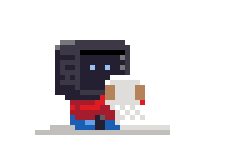GNU roff 1.23 stopped remapping unescaped Hyphen-Minus (ie., - or 0x2D) characters in the input to Hyphen-Minus in the output. Instead, it follows the specified behaviour of converting unescaped Hyphen-Minus characters in the input to Hyphen (ie., ‐ or 0x2010) in the output. To get Hyphen-Minus characters in the output, one needs to escape the Hyphen-Minus with a backslash (ie., \-) in the input [1]. Therefore, the command line options documented in the manuals are no longer prefixed with the Hyphen-Minus character that's needed to ctually use them. This breaks copying and pasting from the manuals and searching within them. Unfortunately, escaping the Hyphen-Minus characters in Markdown doesn't have the intended effect of having Hyphen-Minus in the generated manual pages [2]. Therefore, this is worked around by having the tests check for both Hyphen-Minus and Hyphen. Note that some operating system distributions, like Debian, have reverted this change from GNU roff, but others haven't. So, unless it can be guaranteed that the manuals will always have Hyphen-Minus regardless of which GNU roff version or variant is being used, the tests need to check for both. [1] https://lwn.net/Articles/947941/ https://lists.gnu.org/archive/html/info-gnu/2023-07/msg00001.html https://git.savannah.gnu.org/cgit/groff.git/tree/PROBLEMS?h=1.23.0#n82 [2] https://github.com/cpuguy83/go-md2man/issues/101 https://github.com/containers/toolbox/pull/1398 |
||
|---|---|---|
| .github | ||
| data | ||
| doc | ||
| images | ||
| playbooks | ||
| profile.d | ||
| src | ||
| test | ||
| .codespellexcludefile | ||
| .gitignore | ||
| .gitmodules | ||
| .mailmap | ||
| .zuul.yaml | ||
| CODE-OF-CONDUCT.md | ||
| CONTRIBUTING.md | ||
| COPYING | ||
| gen-docs-list | ||
| GOALS.md | ||
| meson.build | ||
| meson_options.txt | ||
| meson_post_install.py | ||
| NEWS | ||
| README.md | ||
| SECURITY.md | ||
| toolbox | ||
Toolbox is a tool for Linux, which allows the use of interactive command line environments for development and troubleshooting the host operating system, without having to install software on the host. It is built on top of Podman and other standard container technologies from OCI.
Toolbox environments have seamless access to the user's home directory, the Wayland and X11 sockets, networking (including Avahi), removable devices (like USB sticks), systemd journal, SSH agent, D-Bus, ulimits, /dev and the udev database, etc..
This is particularly useful on OSTree based operating systems like Fedora CoreOS and Silverblue. The intention of these systems is to discourage installation of software on the host, and instead install software as (or in) containers — they mostly don't even have package managers like DNF or YUM. This makes it difficult to set up a development environment or troubleshoot the operating system in the usual way.
Toolbox solves this problem by providing a fully mutable container within
which one can install their favourite development and troubleshooting tools,
editors and SDKs. For example, it's possible to do yum install ansible
without affecting the base operating system.
However, this tool doesn't require using an OSTree based system. It works equally well on Fedora Workstation and Server, and that's a useful way to incrementally adopt containerization.
The toolbox environment is based on an OCI
image. On Fedora this is the fedora-toolbox image. This image is used to
create a toolbox container that offers the interactive command line
environment.
Note that Toolbox makes no promise about security beyond what's already available in the usual command line environment on the host that everybody is familiar with.
Installation & Use
See our guides on installing & getting started with Toolbox and Linux distro support.


